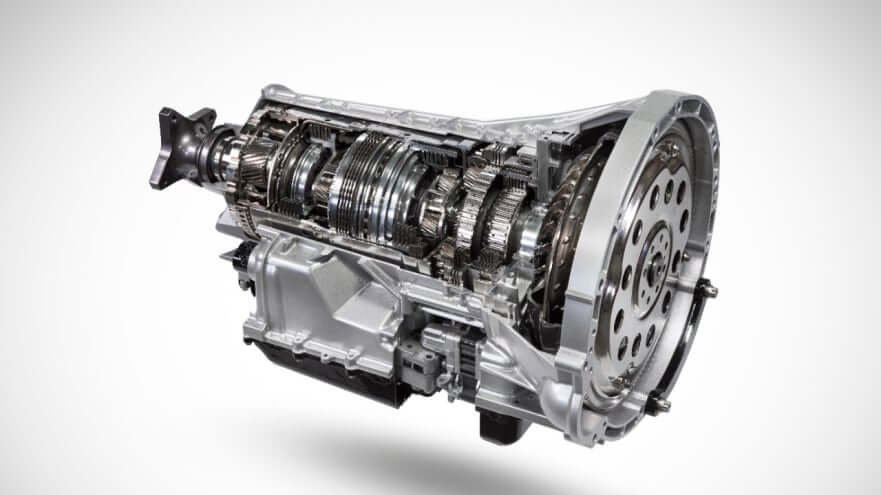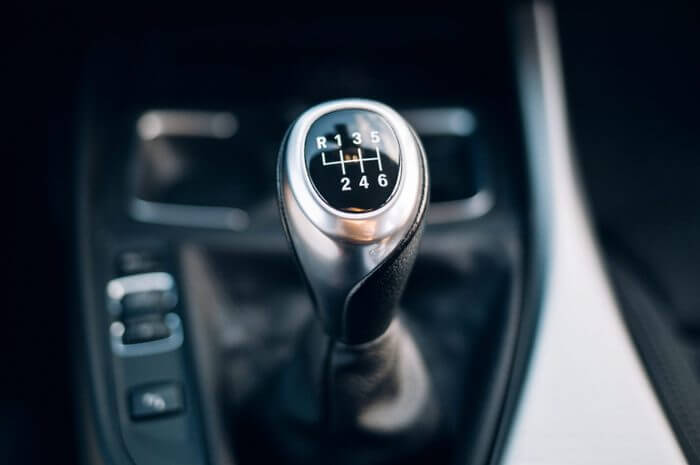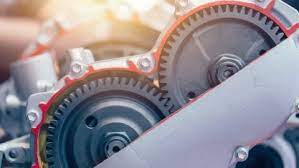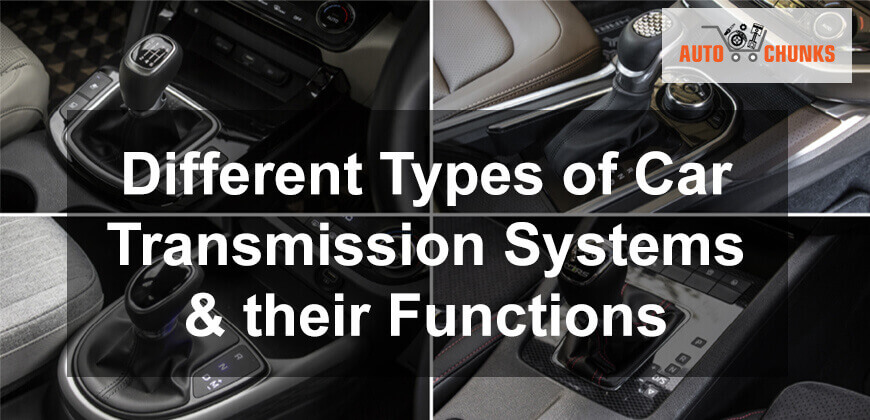A vehicle includes many parts such as an internal combustion engine, car transmission & a hugely complex array of components. Most car owners and drivers will be familiar with the term “car transmission” which is an integral component in any type of vehicle. A car transmission is a vehicle’s gearbox that is roughly analogous to a gear shifter & chain system. This component moves the power from engines to wheels. This component directly communicates with your car’s engine. Without a transmission, it is not possible to drive a car or any other drivable machinery that requires it.
In this blog, we will explain what transmission is, its types, and how these different transmission types function in vehicles that you drive every day.
What is transmission system in automobile?
The first thing you know is what your transmission is. Generally speaking, a transmission is referred to a gearbox in which different levels of gears are used that transmit power from an automobile engine via the driveshaft to the live axle. It is, therefore, also called interchangeably a gearbox. Generally, transmission and gearbox are the same things. Thus, when you drive your car, reverse your car, or just want to keep your beloved car parked for a while, this transmission plays a key role.


Transmission is one of the important elements of the vehicle with the internal combustion engine. This component helps the driver to regulate the speed of the engine based on the power needed. Also, it transmits the power from the engine to the wheels in an optimal way.
In the following sections, we will dive deeper into knowing the types of transmission our cars have and how these various types function in their ways.
Importance of a car transmission in Your Vehicle
A transmission or gearbox functions with the help of the clutch, differential, and rotating shafts. For a moment, try to imagine your car without having a transmission system. What would happen? The wheels turn the same number of times with each crankshaft revolution. Your car could become difficult to control because it will always turn the wheels. And, to stop the car would mean turning off the engine or ignition completely, then starting up the car again means that your car will suddenly jump as soon as you turn the ignition on.
But, that’s not all. Its performance will also be affected poorly, and your car will thus, end up using a lot of fuel. Therefore, having a transmission system in vehicles ensures that your car’s engine revs are to be optimally used, thereby improving its performance, even when you put your car in neutral mode. The neutral gear in a gearbox uses a clutch mechanism that can disconnect the engine communicating with the wheels. This transmission or gearbox is simply an essential and irreplaceable component of any car.
On occurring any kind of transmission issue, you can switch for replacement. Replacement with new autoparts can be more expensive. Hence you should choose other alternatives. Check out the wide range of used transmission prices & find the compatible fit for your car.
Types of transmission system in automobile & their Functions
A transmission system can vary depending on the model of commercial and consumer vehicles that are manufactured by their respective automobile company. This is also a reason why you will see that the gearbox in different cars affects the power.
There are four types of transmission or gearbox created for all kinds of vehicles that operate on the motor engine. These include:
- Manual Transmission
- Automatic Transmission
- Semi-Automatic Transmission
- Continuously Variable Transmission (CVT)
However, this doesn’t stop here. Various auto-mobile engineers and car manufacturers are constantly working to develop new generations of transmission systems that modern vehicles will have as time goes by.
Let’s understand a little more about their types and also, how each of these functions in detail.
1. Manual Transmission
As the name suggests, in a manual transmission system, you are required to manually shift gears using a lever beside you that allows you to select or engage/disengage a gear as you drive along. It includes a clutch that connects the transmission or gearbox to the engine. You can disengage or engage the clutch by pressing and releasing the pressure from the foot pedal. The modern version of the manual transmission system usually has five or six gears (including the reverse and neutral gears).
When cars were first built, since the time of their origin, they all had a manual transmission system. The manual transmission used since the beginning of the motor age. In this transmission system, drivers require to press the clutch pedal, disengage the gearbox from the engine & manually shift the gear to properly operate the vehicle. Using manual transmission also requires certain skills. For operating this system, you should coordinate your left leg on the clutch & right foot on the accelerator gas. After this adjust the gear lever by your right/left hand. Shifting gear also requires coordinated motion to operate the vehicle smoothly, which is often, quite challenging to learn for most people.


A few good things about using manual transmission include the analog feel, high level of driver engagement, and sense of control. That’s why manual transmission is still seen in enthusiasts & sports vehicles. Although the manual transmission may have lesser performance and slower shifting times, they, however, are still highly regarded as the intuitive transmission by some driving enthusiasts to this day. On the other hand, with the increase in new technological innovation toward automatic transmissions, the use of manual transmission in present-day cars is now becoming less popular. But still, there are some best SUVs that come with manual transmission.
Benefits:
- Easy to maintain: As the manual gearboxes are less complex than the automatics. Hence drivers have more control over shifting & regulating the speed. This clutch is the only item that needs repair, but for other parts, doesn’t require hundreds of thousands of miles.
- Better fuel economy: Automatic vehicles include a torque converter & a hydraulic pump. It is possible that manual transmission boosts your vehicle’s fuel efficiency from 5 to 15%.
- More affordable: one of the main benefits of using manual gearboxes is cost. Manual transmission is offered in the market at a low cost. And the vehicles with manual transmission are also available at a low cost.
2. Automatic Transmission
Although the manual transmission system has been in use in various vehicle models for a very long time (rather since its origin), however, it seems that it’s nearing its end quite soon. The transmission system is now being replaced by semi-automatic and fully automatic transmission systems.
Most modern vehicles have an in-built computerized system that is capable of doing the shifting of gears automatically. The driver simply needs to shift the different gear modes, for instance, from P (Park) to D (Drive) or N (Neutral), depending on one’s driving conditions and the rest is automated. This system automatically shifts the gears without a direct input of a human being. It selects the gear through engine speed, car speed, gearbox selection mode, stability control, traction control, cruise control & braking.


Thus, the concept of working with an automatic transmission system is quite simple. When the driver puts his/her vehicle in the gear “D” mode (for drive), the gearbox will execute shifting automatically to the desired mode. Note that there is no clutch pedal used, only the brake and the accelerator. This type of transmission system makes driving a car a much easier experience to operate.
While most drivers would find the automatic gearbox simple and easy, however, this may not be that simple for certain drivers. It could perhaps, be a much more complicated thing than the manual, especially since the modern transmissions may have complex electronics built into the vehicle for its proper functioning. The automatic transmission system comprises a torque converter that replaces the clutch mechanism seen in a manual transmission system. It also aids in shifting gears smoothly and without requiring the driver’s input. The automatic gearboxes began providing 2 or 3-speed units. Today, most modern automatic transmissions provide 8-speed or even 10-speed gears. Having a large number of gears is better for using the power of high efficiency & performance.
Thus, the benefits of this automatic transmission system in modern vehicles are a more relaxed driving experience, efficiency, and practicality.
Features:
Easy to drive: Many people prefer vehicles with automatic transmission. In this transmission the vehicle shifts the gears itself, i.e, you just navigate your vehicle & keep your eyes on the road. This system gives a great driving pleasure.
Acceleration speed: In an automatic transmission, the accuracy of the torque converter increases the acceleration speed over a manual transmission from a dead stop. It helps to accelerate quickly. Also, it provides accurate & effortless shifting of gears.
3. Semi-Automatic Transmission
A semi-automatic transmission system is a hybrid gearbox system between a manual and an automatic transmission. Thus, a simple shifter or paddles behind the steering wheel is instrumental in changing the gears when required, just like in a manual gearbox. However, you don’t need to use a clutch pedal, similar to what you would have done in a car with an automatic transmission system. Once you change the mode of the transmission, all the parameters i.e., sensors, processors, actuators, and pneumatics, will also be changed electronically by the gearbox.


These semi-automatic gearboxes are mostly used in heavy-duty commercial-grade vehicles. The recent models using this type of transmission or gearbox system provide almost an instant and indiscernible shift of the gears.
4. Continuously Variable Transmission (CVT)
Unlike other types of transmission or gearbox in cars as seen above, the continuously variable transmission (CVT) system does not use gears as the means of changing speeds. It uses a metal or rubber belt for shifting. This belt runs over pulleys to keep its optimum tension. Even you can use a metal or rubber belt for this purpose. The belt requires various pulleys action to create the same effects as the gears.


This type of transmission helps in generating efficient speed in a vehicle. Regardless of the weight that the car is hauling, the pulleys can make the perfect adjustment to make the engine run at the maximum speed.
Conclusion
Among all the car transmission types we’ve seen, so far the manual and automatic transmission types are the most popular ones. Their use is common in several models of both commercial and consumer vehicles.
On the other hand, the semi-automatic and CVT transmission systems are found only in specific vehicle models. So, if you are considering the availability and ease of use, then the automatic transmission or gearbox is the best option. Although learning to operate a manual transmission may be quite challenging to master, at least for some, but it does provide the best experience in any kind of road and conditions.


Write A Comment